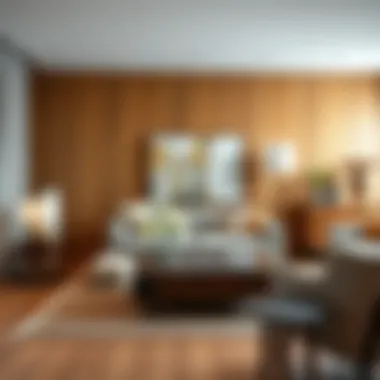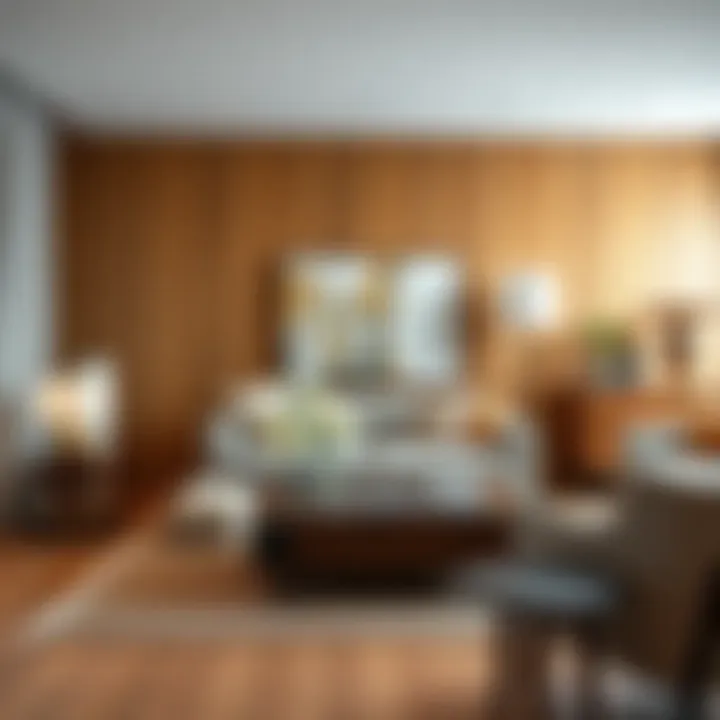Exploring Bare Wood: Elegance in Fine Furniture


Intro
Bare wood holds a captivating allure, one that seems to speak to a timeless craftsmanship and a connection to nature. In today’s fast-paced, mass-produced world, fine wood furniture emerges as a symbol of elegance and authenticity in our homes. This isn’t merely about aesthetics; it’s about the essence, character, and longevity that quality wooden pieces can bring into our living spaces.
For homeowners, renters, designers, and DIYers, understanding the nuances of wood types, finishes, and care techniques is essential. It's not enough to appreciate a beautifully crafted table or chair without knowledge of its material and structural integrity. Such awareness informs purchasing decisions, maintenance practices, and ultimately, how these pieces will fit within one's design philosophy. Throughout this exploration, we’ll delve deep into these aspects, guiding you to appreciate bare wood's intrinsic value. Each section will peel back layers to reveal insights into the trending styles, DIY projects, and the ultimate care needed for these natural wonders.
Furniture Trends
Current Market Trends
Keeping abreast of the currents in the furniture market reveals much about the evolving preferences of consumers. Today, there’s a growing inclination towards minimalism that embraces raw, bare wood. This trend transcends mere appearance; it signifies an appreciation for authenticity. Mixed materials are also very much in vogue, with combinations of wood, metal, and fabric celebrating contrast while remaining cohesive.
Moreover, sustainability is at the forefront. More buyers are scrutinizing the origins of their wooden furniture, opting for pieces that come from responsibly managed forests. As a result, brands that highlight their commitment to eco-friendly practices are gaining traction among consumers who prioritize environmental stewardship.
Popular Styles and Designs
The realm of fine wood furniture is as diverse as it is beautiful. From Scandinavian designs, known for their simplicity, to more eclectic styles that mix various wood types and finishes, there’s something for everyone. Below are some styles that have captured the imagination of many:
- Mid-Century Modern: Characterized by clean lines and organic curves, these pieces often utilize walnut and teak, bringing warmth and sophistication to any room.
- Industrial Style: Often incorporating reclaimed wood, this aesthetic features rugged metal accents and minimalistic designs, reflecting urban chic.
- Rustic Farmhouse: This style celebrates the natural imperfections of wood, creating cozy and inviting spaces infused with a sense of nostalgia.
"In the right light, bare wood can tell a story; every knot and grain a chapter of its journey."
Each of these styles opens unique possibilities for personal expression within your space. As you explore the world of fine wood furniture, you will find not just stylish pieces but those imbued with enduring appeal and character.
DIY Projects
Step-by-Step Guides
For those who enjoy a hands-on approach, creating your own pieces from bare wood can be both rewarding and cost-effective. Whether crafting a simple bookshelf or a sophisticated dining table, here’s a basic outline to get you started:
- Choose Your Wood: Pick a type that resonates with you, considering both the aesthetic and practical aspects.
- Gather Tools: Ensure you have essentials like a saw, sandpaper, wood glue, and finish.
- Measure and Cut: Precision is key here—mark your cuts clearly and take your time.
- Assemble: Use wood glue to bind pieces together, reinforcing with screws or nails where necessary.
- Finish: Sand down to smoothness, and choose your desired finish, whether it be oil, lacquer, or a simple sealant.
Budget-Friendly Ideas
DIY projects don’t have to break the bank. Consider these creative and budget-conscious ideas:
- Upcycled Furniture: Transform thrifted finds with a coat of paint or a fresh finish.
- Small Decor Items: Create items like coasters, wooden trays, or simple wall art using scrap wood left over from other projects.
- Collaborative Pieces: Join forces with friends for a woodworking party; sharing tools and resources can help reduce costs.
By learning to harness the beauty of bare wood, you not only cultivate an appreciation for craftsmanship but also create pieces that speak to your personal style and needs.
As you navigate through this exploration of fine wood furniture, insightful choices await you—be it in your next purchase or your own DIY endeavor.
Understanding Bare Wood
In the world of fine wood furniture, understanding bare wood is akin to knowing the soil from which a plant grows. It sets the stage for a multitude of choices that can shape the aesthetic appeal and functional capabilities of your living spaces. There's a certain elegance to bare wood that speaks volumes about craftsmanship, authenticity, and design integrity.
A major benefit of recognizing the importance of bare wood lies in its myriad of textures, flavors, and personalities. Each piece tells a story, influenced by its origin, grain, and how it interacts with light and environment. Homeowners and designers alike can draw upon this wealth of characteristics to create stunning focal points or harmonious backgrounds in their interiors.
This section lays the groundwork for what follows by highlighting the various elements that delineate the spectrum of bare wood. It explores definitions and attributes, types of wood, and contrasts natural finishes with stains. With that awareness, you can make insightful choices that resonate with your style and needs.
Definition and Characteristics
Bare wood refers to timber that has not been treated with any finish, stain, or sealant. It showcases the wood's inherent beauty, featuring unique grain patterns, colors, and textures that are often masked when finishes are applied. When you examine bare wood closely, you might notice its gentle curves, knots, and flecks that can captivate the eye. Each piece contributes to a story that celebrates nature's artistry.
The primary characteristics of bare wood encompass not just visual elements, but also tactile sensations. It possesses warmth to the touch and can evoke a sense of connection to the natural world. Furthermore, bare wood is relatively easy to customize later on with finishes or stains, allowing for versatility in achieving different aesthetics.
Types of Wood
Diving into types of wood helps decipher the rich diversity available when selecting fine furniture. Understanding the various categories, such as hardwoods, softwoods, domestic and exotic woods, opens up a vast landscape to explore.
Hardwoods vs. Softwoods
Hardwoods come from deciduous trees that shed their leaves seasonally, while softwoods originate from conifers that keep their needles year-round. This distinction doesn’t just affect the classification; it speaks to the physical properties of the wood itself. Hardwoods, like oak and walnut, are renowned for their durability, making them a popular choice for high-quality furniture. Their resistance to wear and tear means a well-crafted piece can be passed down through generations.


On the flip side, softwoods like pine and cedar offer readily available options that are generally lighter and easier to work with. Each type has its specific benefits. For instance, softwoods typically cost less and are better suited for DIY projects. Whether you lean towards the everlasting strength of hardwoods or the practicality of softwoods, both categories have something unique to offer to furniture design.
Domestic vs. Exotic Woods
Domestic woods, harvested from local trees, often present advantages such as lower costs and a stronger connection to regional styles. Examples include maple and cherry, which are frequently transformed into beautiful pieces for the home. Their familiarity creates a sense of comfort and warmth in modern spaces.
Conversely, exotic woods like mahogany and teak offer striking visual qualities and a unique appeal, thanks to their rarity and distinct patterns. However, they can come with higher prices and a set of ethical concerns related to sourcing. This dichotomy urges thoughtful consideration about selection and sustainability, which should always be at the forefront when choosing materials for fine wood furniture.
Common Species in Furniture Making
When it comes to common species in furniture making, oak, walnut, and cherry often dominate discussions. Oak’s durability makes it a sturdy choice, while walnut brings a rich range of colors that can elevate any design. Cherry’s warm tones tend to darken with age, creating depth and a vintage aesthetic as time passes. Each species possesses unique characteristics that cater to different design visiones, functions, and personal preferences.
Natural Finish vs. Stains
The contrast between natural finishes and stains can significantly influence the end result of your furniture piece. A natural finish allows the wood’s inherent beauty to shine through, preserving its texture and unique grain pattern—acting almost like a magnifying glass for the character of the wood itself. On the other hand, stains change the wood’s color while highlighting or muting certain features, giving a whole different feel to the same piece.
Choosing between them should be infused with deliberation. The finish you select ultimately reflects your style while ensuring the longevity of the furniture. Each option has its merits, depending on the desired effect and function of the piece within your living space.
The Allure of Fine Wood Furniture
The charm of fine wood furniture transcends its physical form; it embodies an artistry and craftsmanship that touches on human emotion and aesthetic appreciation. Hardwood or softwood, the essence of fine wood resonates with anyone who walks into a space adorned with carefully chosen pieces. What makes fine wood furniture stand out is its blend of beauty, durability, and functionality, each contributing to the household in unique ways. The allure isn’t just skin-deep; it encompasses a rich narrative of history, craftsmanship, and a connection to nature that manufactured items rarely achieve.
Aesthetic Qualities
Grain Patterns and Textures
Grain patterns and textures found in wood are like fingerprints; no two pieces are exactly the same. This uniqueness adds to the furniture's character. When you observe a tabletop made from walnut, the deep, swirling grains tell a story that mass-produced surfaces simply can’t. Features like figured maple present a sense of movement, dazzling the eye with their complexity. These textures not only draw attention but also engage the fingertips, creating a tactile experience that is pleasing. Besides the visual delight, the different grains can augment the perception of depth in a room, making it feel more inviting. A piece of furniture, with a striking grain, often becomes a conversation starter, elevating the ambiance of any gathering.
Color Variations in Different Woods
Color variations in woods present another layer of beauty. Imagine a cherry wood side table that deepens into a rich reddish hue over time, or the cool, calming tones of ash that can lighten up a space. Each type of wood carries its color identity, heavily influenced by both its natural properties and the finishing techniques applied. Choosing woods not only based on their aesthetic appeal but how they interact with other elements in the same room can transform a space. However, it’s vital to consider that some colors may fade when exposed to sunlight, necessitating careful placement to maintain vibrancy.
The Role of Finishing Techniques
Finishing techniques are the final touch that can transform a raw wood piece into a stunning work of art. Techniques like oiling, staining, or varnishing can highlight the wood’s grain while protecting it from everyday wear. This is particularly relevant when discussing fine wood furniture, which can be an investment. A well-finished piece is not just beautiful—it's also safeguarded against damage. However, selecting the right finish demands knowledge of intended usage. For instance, a lighter finish may be more susceptible to scratches than a robust polyurethane coating. Striking the balance between aesthetics and protection takes a discerning eye.
Construction and Craftsmanship
Joinery Techniques
Joinery techniques are the backbone of furniture construction. How two pieces of wood come together can determine the furniture's strength and longevity. Traditional methods like dovetail or mortise-and-tenon joints exhibit craftsmanship that speaks to the quality of the piece. Their intricate execution often adds an architectural dimension that can be visually appreciated. Proper joints enhance overall stability, ensuring that the furniture stands the test of time. However, some modern techniques, while efficient, may lack the charm of traditional ones, sometimes leading to a perception of lesser value.
Handcrafted vs. Mass-Produced
When it comes to fine wood furniture, the conversation often pits handcrafted items against mass-produced alternatives. Handcrafted pieces radiate individuality; each item is a unique creation, bearing the mark of the artisan’s skill. This hands-on approach often results in higher quality, but can come with a steeper price. Mass-produced furniture, on the other hand, offers affordability and accessibility. However, it often lacks the personal touch that differentiates fine wood furniture. It’s a trade-off for buyers—balancing individuality with practicality.
The Impact of Craftsmanship on Value
The level of craftsmanship involved in making fine wood furniture has a direct impact on its value. Superior craftsmanship often means a longer-lasting piece that can be passed down through generations. This heritage quality is something many buyers seek, as it ties into deeper emotional connections. A well-crafted chair or table tells a tale, making it more than just a functional item. Yet, the higher cost of meticulously crafted items can deter some buyers, who might question if the investment justifies the price. Ultimately, an appreciation for quality versus quantity can guide purchasing decisions.
Functional Benefits
Durability and Longevity
Durability is perhaps one of the most appealing functional benefits of fine wood furniture. Crafted from premium materials, pieces can withstand the rigors of daily life. A solid oak dining table can endure countless family gatherings, while softer woods like pine may show wear more quickly. The longevity of furniture made from quality wood often aligns with sustainability values, as it reduces the need for replacements. However, the cost of entry for durable pieces can be concerning for budget-conscious consumers, leading some to second-guess their options.
Timelessness of Design
Fine wood furniture often features designs that remain relevant through changing trends. The classic silhouette of a well-crafted wooden chair can fit into both modern and traditional settings seamlessly. This timelessness ensures that your investment is not only functional now but will also serve you well years down the line. Trends may come and go, but solid wood furniture possesses a presence that continues to resonate. Consumers, however, may feel pressure to follow trends over timeless pieces, fearing their choices may quickly become outdated.
Comfort and Usability
Finally, the aspect of comfort is crucial in any living space. Fine wood furniture, when crafted with user experience in mind, promotes usability. Ergonomic designs envelop the user in a way that goes beyond aesthetics, ensuring that everyday activities—from dining to relaxing—are enjoyable. Comfortability paired with fine craft can make a lasting impression on guests. Nonetheless, some might find that natural wood finishes can be prone to scratches, which might affect their long-term appreciation for their comfort and usability.
Maintaining Bare Wood and Fine Furniture


Maintaining bare wood and fine furniture is not just about keeping things tidy; it’s about preserving the beauty and character of the wood. Proper maintenance can extend the lifespan of these items, making them not only cherished possessions but also functional parts of our homes. When we invest in quality wood furniture, we expect it to age gracefully, becoming a part of our living spaces for years to come. Thus, understanding how to care for these pieces is crucial for every homeowner or designer.
Caring for Bare Wood Finish
Cleaning Techniques
Keeping bare wood finishes clean is a fundamental step in maintaining their integrity. Regular dusting with a soft, lint-free cloth is often enough to prevent buildup that can scratch or dull the surface. An occasional wipe with a damp cloth, followed by immediate drying, helps keep the wood from absorbing excess moisture. The unique feature of using minimal liquid is its effectiveness without the risk of damage that heavier cleaners might cause. This simple approach is beneficial in preserving the natural luster of bare wood, ensuring that furniture not only looks good but is also protected from potential harm.
Protective Measures
Implementing protective measures is vital in keeping fine wood furniture in good condition. Some homeowners use felt pads under heavy items to prevent scratches, while others apply coasters to shield surfaces from liquid spills. These measures are exceptionally effective and go a long way in preventing damage from everyday wear and tear. A key characteristic of these protective techniques is their simplicity; they require little effort but offer significant results. The trade-off, of course, is the need for consistent vigilance, as neglecting these precautions can lead to costly repairs.
Appropriate Products to Use
Choosing the right products for maintaining bare wood is equally important. Natural oils, like Danish oil or tung oil, can enhance the grain while providing some protection against moisture. While these products are popular due to their ability to penetrate the wood deeply, they do require reapplication over time. This reapplication can be cumbersome for some, but the end result—a beautifully enriched surface—often makes it worth the effort. Using inappropriate cleaning agents, such as ammonia-based cleaners, can strip away the natural oils and finish, leading to deterioration. Therefore, selecting appropriate products plays a pivotal role in sustaining the visual appeal and structural integrity of wood furniture.
Preserving and Restoring Fine Wood Furniture
Identifying Damage Types
Understanding the different types of damage that can occur to wood furniture is crucial for effective preservation and restoration. Common issues include scratches, dents, and water stains, each requiring a unique approach for repair. Recognizing specific damage types helps in choosing the right solutions, turning potential disasters into manageable fixes. The emphasis on identification cannot be overstated; knowing whether a scratch is superficial or deep determines whether a simple polish or a more invasive repair method is necessary.
Methods for Restoration
Various methods can be employed for restoring fine wood furniture, ranging from DIY solutions to professional interventions. Small scratches can often be fixed with a wax fill or touch-up markers, while more significant issues may necessitate sanding or refinishing. The key here is understanding the scope of the damage; not all furniture requires a complete overhaul. A tailored approach not only preserves the piece's integrity but also retains its character. Choosing the right method is crucial, as mishaps during restoration can sometimes do more harm than good, making professional help a viable consideration for intricate repairs.
When to Seek Professional Help
At times, despite our best efforts, certain situations call for professional expertise. When damage goes beyond superficiality—such as deep cracks, extensive water damage, or structural issues—bringing in a skilled restorer might be necessary. Seeking professional help ensures that your furniture receives the specialized attention it requires, utilizing tools and techniques not typically available to the average homeowner. While it can be an investment, the assurance that your valuable pieces are in capable hands often brings peace of mind. Moreover, it can prove more cost-effective than attempting DIY repairs that may lead to further damage.
In summary, maintaining and preserving bare wood and fine furniture requires a thoughtful approach, focusing on cleaning, protection, and restoration strategies. Through vigilance and care, one can ensure these pieces continue to enhance the aesthetics and functionality of living spaces for years to come.
Incorporating Wood Furniture into Design
Integrating wood furniture into your living space transcends mere decoration; it’s a thoughtful endeavor aimed at enhancing both aesthetic appeal and functional value within your home. Wood’s versatility can harmonize with various design styles, providing a timeless quality that resonates with many decor enthusiasts. Understanding how to effectively incorporate wood into your design can lead not just to a visually striking environment, but also to a space that reflects comfort, warmth, and sophistication.
Choosing the Right Pieces
Assessing Space and Scale
When it comes to choosing furniture, the aspect of assessing space and scale can’t be overstated. This step is vital because it sets the foundation for how each piece will interact with its environment. The right dimensions ensure that your space flows well without feeling cramped or disjointed. A key characteristic here is knowing that furniture should complement, not overwhelm, other elements in the room. It’s a popular choice in design because a well-scaled piece can create balance and allows for unobstructed movement.
A unique feature of proper assessment might involve taking measurements and visualizing placement before you leap. This could be done with tape on the floor or even digital room planners. The greater advantage? Avoiding the headache of purchasing something that simply doesn’t fit. It saves time, money, and frustration, making it a smart strategy for any homeowner.
Mixing Materials in Design
Mixing materials is another enriching avenue for incorporating wood into your design. It adds depth and interest, allowing wood to shine amidst contrasting textures and colors. This approach harmonizes hard surfaces with soft ones, giving a cozy yet dynamic look that grabs attention. The key characteristic that draws design enthusiasts to this method is the unexpected way different materials can enhance the beauty of wood.
That said, a notable feature of this mixture can be choosing materials like metal or glass in conjunction with wood. These combinations can elevate a room from mundane to memorable, creating focal points that encourage conversation. However, a downside might be ensuring balance; too many clashing materials can lead to a chaotic atmosphere, so it’s essential to strike a thoughtful balance.
Aligning with Personal Style
Finally, every design choice must relate back to your own personal style. Selecting pieces that resonate with your taste can turn any room into a sanctuary that's truly you. The key characteristic here is authenticity—your home should reflect who you are, and wood allows for that expression to shine through. A popular choice in this regard could involve selecting rustic or contemporary wood pieces, depending on whether you gravitate towards a traditional feel or a modern aesthetic.
A unique aspect of this alignment is how certain pieces can enhance memories—a handcrafted oak dining table might evoke nostalgia from family dinners. Conversely, you might find sleek, minimalist designs appealing. Just be aware that your choices should not only look appealing but also work cohesively together, combining to form a narrative that represents your individual story.
Creating Contrast and Harmony
Complementing Other Furnishings
Creating contrast and harmony is all about ensuring your wood furniture complements other items in your space. This aspect is crucial as it can unify disparate elements into a cohesive look. By thoughtfully selecting furnishings that either match or pleasantly contrast with your wood pieces, you create a space that feels orchestrated.
A key characteristic here is choosing colors and styles that either match or soften each other. For instance, pairing a dark walnut coffee table with light linen sofas immediately instills life into a room. The unique feature lies in its effectiveness; this approach not only brings visual interest but also fortifies a sense of balance. However, be cautious; too strong a contrast may overwhelm the space, creating an inflexible atmosphere.
Color Schemes and Balance


Color schemes play a significant role in establishing harmony. A well-thought-out color palette can elevate the beauty of wood furniture significantly. From earthy tones that emphasize natural hues to bold colors that create striking contrasts, there’s ample opportunity for creativity.
The key characteristic of a successful color scheme revolves around how colors interact. For instance, using hues that echo the wood’s tones can create a serene environment, allowing the wood's elegance to shine through. The unique feature, being aware of seasonal changes or lighting shifts, adds another layer of depth to your color decisions. However, failing to choose a balanced scheme might lead to a cluttered look, which diminishes wood’s inherent beauty.
Lighting Considerations
Lighting is fundamental when considering how wood furniture will be viewed and appreciated within a space. It can influence how the colors and textures appear at different times of the day. A well-considered lighting scheme can enhance the features of fine wood, highlighting its grain and richness.
The key characteristic of good lighting is its ability to set the mood and create an atmosphere. Natural light can bring warmth, while strategically placed lamps might produce an inviting glow that softens edges. A unique aspect of this is that the interplay of shadows and light can dramatically alter how wood is perceived in your space. However, poor lighting choices can undermine even the best wood pieces, rendering them dull and lifeless.
Ultimately, incorporating wood furniture into your design is an art that blends thoughtful selection with creativity, positioning your space not just as a living area but as an experience that reflects your values and style.
Sustainable Practices in Wood Furniture
The increasing awareness about environmental issues has brought sustainable practices to the forefront, especially in the realm of home furnishings. As homeowners and designers alike seek authenticity and uniqueness in their spaces, understanding sustainable wood furniture shifts the focus from aesthetics alone to a deeper connection with our planet. The ethics surrounding wood sourcing not only satisfy a growing customer demand for eco-friendly options but also contribute to preserving forests and maintaining biodiversity. With wood furniture pieces often seen as investment items, it’s crucial to consider the sustainability aspect that could potentially enhance the value and longevity of such investments.
Ethical Sourcing of Wood
Credentialing Sustainable Forestry
Credentialing sustainable forestry is a vital benchmark in assessing the environmental impact of wood furniture. This system involves certification by organizations like the Forest Stewardship Council (FSC), ensuring that wood comes from responsibly managed forests that provide environmental, social, and economic benefits. The key characteristic here is traceability—the ability to track wood right from its source to the final product. Choosing certified wood often appeals to consumers who want to affirm their commitment to sustainability. One unique feature of this practice is that it encourages forest owners to adhere to high standards, which can positively impact biodiversity and soil health.
However, certification processes can be complex and sometimes point to a higher cost for the end product. But this cost typically reflects a conscious choice to support ethical practices in the industry. Through credentialing, we not only promote responsible harvesting but also ensure that the artistry of fine wood furniture does not hurt the earth.
Impact of Deforestation on Quality
The negative impacts of deforestation stretch beyond the environmental; they touch the essence of quality in wood furniture. When forests are heavily logged, it depletes the natural habitat, leading to the deterioration of wood quality over time. A key characteristic of wood sourced from deforested areas is its inconsistency—irregular grain patterns and compromised structural integrity emerge as several tree species struggle to thrive under stress. In essence, the lack of sustainable practices leads to a vicious cycle where low-quality wood ends up being the norm.
Moreover, what many don’t realize is that trees play a crucial role in regulating the climate. As they disappear, the projects and buildings made from such wood could eventually involve increased maintenance costs and lower resale value. Choosing to avoid wood linked to deforestation is beneficial not just for the planet, but also for ensuring the longevity and durability of furniture that homeowners invest in.
Choosing Reclaimed Wood
Reclaimed wood offers a brilliant avenue for sustainable furniture. This practice involves salvaging wood from old structures like barns, factories, or even shipyards to create stunning furniture pieces. The key benefits of choosing reclaimed wood revolve around its unique aesthetic—each piece tells a story with its character, knots, and weathered textures that might be absent in newly sourced timber. This environmentally friendly choice reduces the need for new lumber while adding a sense of rustic charm to homes.
One unique feature is that reclaimed wood often comes with a patina that cannot be replicated, making each piece one-of-a-kind. However, working with reclaimed wood can come with its caveats; it may require more effort to treat and finish correctly as historical wood can harbor unseen damage or pests. Despite these challenges, the advantages far outweigh the disadvantages when it comes to the positive impacts on sustainability and the depth of character let into interior spaces.
Eco-Friendly Finishing Options
Natural Oils and Waxes
When it comes to eco-friendly finishes, natural oils and waxes stand out as an excellent choice for preserving the beauty of wood while ensuring environmental sustainability. Products like tung oil or beeswax nourish the wood and enhance its natural grain without introducing harmful chemicals. The key advantage is the maintenance of a wood's authenticity—these finishes allow the wood to breathe while resisting moisture. Perhaps the most appealing aspect is their low toxicity level, making it safer for both the environment and individuals in the home, particularly those with sensitivities to volatile organic compounds (VOCs).
The beauty of oils and waxes lies in their ease of application. However, they necessitate regular maintenance to remain effective, which might not suit everyone's lifestyle but offers a rewarding commitment to preserving the wooden masterpiece.
Water-Based Finishes
Water-based finishes have started gaining popularity in recent years. They are known for their quick drying time and easy cleanup, making them a convenient option for both seasoned craftsmen and DIY enthusiasts. A major characteristic that draws people to water-based finishes is their minimal odor, which greatly contrasts with their oil-based counterparts. As these finishes contain fewer VOCs, they align naturally with the growing trend of environmentally conscious living.
However, they might require a little more finesse to apply correctly to achieve a flawless finish. Since water-based products can raise wood grain if not properly prepped, they can involve a steeper learning curve. Nevertheless, the benefits of quicker drying times and minimal environmental impact have positioned them as a top choice for contemporary woodworking.
VOCs and Health Considerations
VOCs, or volatile organic compounds, have long been a topic of concern within the realms of home furnishing and finishing products. These compounds can evaporate into the air, potentially leading to respiratory issues and other health problems. A critical characteristic when looking at wood finishes is their VOC content. Options with low or no VOCs are becoming increasingly popular among homeowners aiming to create a safe living environment. The advantages of choosing low-VOC finishes contribute not only to health but also to a better air quality inside homes.
The downside, however, involves potential trade-offs. Finishes with minimal VOCs may not perform as robustly as traditional finishes. They can wear down faster or might necessitate more frequent applications. Ultimately, weighing the health benefits against the performance aspect can help ensure a well-informed choice when considering various wood finishing alternatives.
Closure
As we wind down this exploration into the elegance of fine wood furniture, it’s vital to recognize the multifaceted significance of choosing bare wood as a key element in home decor. This isn't just about aesthetics; it brings forth several benefits that enhance our living environments and align with our values as consumers. The gravity of material selection resonates deeply with sustainability, craftsmanship, and functionality.
Summary of Key Points
In this article, we ventured through various aspects of bare wood and fine furniture:
- Understanding Bare Wood: We defined what bare wood is and examined different types, emphasizing the rich characteristics that each wood species brings to the table. The contrast between hardwoods and softwoods clarified their specific applications in furniture making, while domestic versus exotic woods illuminated choices for every budget.
- The Allure of Fine Wood Furniture: The aesthetic qualities of wood, from stunning grain patterns to color variations, capture the heart of design. Expert craftsmanship, especially intricate joinery techniques seen in handcrafted items, enhances both beauty and value, making these pieces functional works of art.
- Maintaining Bare Wood: We discussed fundamental care tips, from cleaning techniques to protective measures that extend the life of furniture, ensuring it remains a cherished asset in one's home.
- Incorporating Wood Furniture into Design: Key considerations about size, space, and personal style emerged as essential factors in successful interior design with wooden pieces. Creating contrast and harmony between materials creates a balanced aesthetic that pleases the eye.
- Sustainable Practices in Wood Furniture: The importance of ethical sourcing and eco-friendly finishing options signals a growing awareness of our environmental footprint. Choosing reclaimed wood or responsibly sourced timber not only benefits our homes, but it also contributes to the larger goal of preserving our forests for future generations.
Future Trends in Wood Furniture
As we look ahead, the future of wood furniture appears promising, influenced by several evolving trends:
- Increased Demand for Sustainable Products: Consumers are more environmentally conscious than ever. Expect to see continued growth in reclaimed and sustainably sourced woods as homeowners search for pieces that reflect a commitment to environmental stewardship.
- Integration of Technology and Craftsmanship: The intersection of traditional woodworking techniques with modern technology is creating unique designs that appeal to new generations. CNC machines, for instance, allow for intricate patterns and customizations, marrying craftsmanship with innovation.
- Customization and Personalization: More than a trend, personalization becomes a necessity as consumers seek to express their individuality in their homes. Tailoring furniture pieces to suit specific tastes and spaces will likely become standard practice in the industry.
- Hybrid Materials: We can expect an exploratory blend of materials alongside wood. Pairing wood with metals or textiles can enhance the overall functionality while creating a distinctive design language that stands out.















